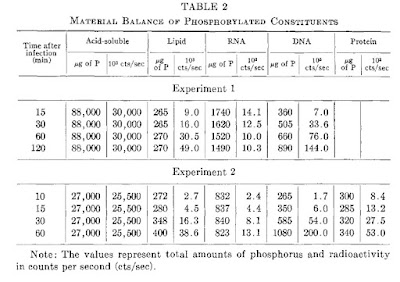 One of my favorite features out there on the blogosphere, John Dennehy's Citation Classic of the Week, this week discusses the story of a somewhat obscure paper that reports the author's rather unwitting discovery of mRNA. Volkin and Astrachan managed to detect incorporation of radioactive phosphorus into the RNA fraction of phage-infected E coli, into molecules whose base composition resembled that of phage DNA molecules. Judging from their discussion of the results, they didn't really seem to immediately appreciate the true significance of what they had found. Interestingly, people at the time were hung up on the fact that abundant ribosomal RNA was likely the protein-encoding message, rather than this "minor species" of "DNA-like RNA" that Volkin and Astrachan had detected. Naturally, none other than a super-team of molecular biology super-heroes, Brenner, Crick and Monod, saved the day and put it all together: based on the data of Volkin and others, this minor species was indeed the messenger nucleic acid that directed protein synthesis. Read more about the affair over at The Evilutionary Biologist.
One of my favorite features out there on the blogosphere, John Dennehy's Citation Classic of the Week, this week discusses the story of a somewhat obscure paper that reports the author's rather unwitting discovery of mRNA. Volkin and Astrachan managed to detect incorporation of radioactive phosphorus into the RNA fraction of phage-infected E coli, into molecules whose base composition resembled that of phage DNA molecules. Judging from their discussion of the results, they didn't really seem to immediately appreciate the true significance of what they had found. Interestingly, people at the time were hung up on the fact that abundant ribosomal RNA was likely the protein-encoding message, rather than this "minor species" of "DNA-like RNA" that Volkin and Astrachan had detected. Naturally, none other than a super-team of molecular biology super-heroes, Brenner, Crick and Monod, saved the day and put it all together: based on the data of Volkin and others, this minor species was indeed the messenger nucleic acid that directed protein synthesis. Read more about the affair over at The Evilutionary Biologist.(Above figure is from Volkin and Astrachan, Virology, v2 pg. 149 (1956).


 Podcast
Podcast

1 comments:
another interesting point this paper makes clear is that the only difference between molecular biology and metabolism is sequence information (ok, with maybe some structure sprinkled in there too). if they hadn't determined base composition - an old school surrogate for sequencing - then this paper is just plain old metabolic turnover, no different than some boring old ox-phos or glycolysis assay.
Post a Comment